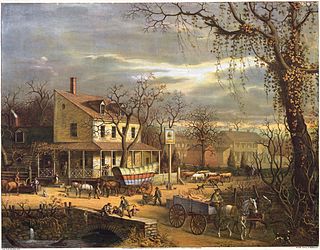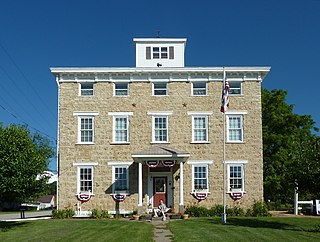Related Research Articles

Inns are generally establishments or buildings where travelers can seek lodging, and usually, food and drink. Inns are typically located in the country or along a highway; before the advent of motorized transportation they also provided accommodation for horses.

The Captain Elisha Phelps House is a historic house museum at 800 Hopmeadow Street in Simsbury, Connecticut. The colonial-era house was built by David Phelps in 1711. His son Elisha Phelps received the land from his father and expanded the house in 1771. Elisha Phelps along with his brother Noah Phelps and others took part in the capture of Fort Ticonderoga in 1775. Capt. Phelps was appointed as commissary of the Northern Department by the Continental Congress.

Stacy's Tavern is a historic wayside stagecoach inn in the village of Glen Ellyn in DuPage County, Illinois. It was added to the National Register of Historic Places on October 29, 1974.

Putnam Cottage was also known as Knapp Tavern during the American Revolution. It is located at 243 East Putnam Avenue, on the former route of the Boston Post Road, in Greenwich, Connecticut.

Poquetanuck is a village in the town of Preston, Connecticut, located near the banks of a bay known as Poquetanuck Cove that opens to the Thames River. The village includes the National Register of Historic Places (NRHP)-listed Poquetanuck Village Historic District.

The Thompson–Fasbender House, located at 649 West 4th Street in Hastings, Minnesota is listed on the National Register of Historic Places. It was built in 1880 by William Thompson who came to Minnesota in 1857 from Maine. He was a banker, wheat-buyer, and land-owner who also was part-owner of a saw mill and door and sash factory. His access to woodworkers is reflected in the home's finishing. Its Second Empire architecture is reflected in its mansard roof featuring scalloped wooden shingles and bracketed cornices.

The Rudolph Latto House is a historic house in Hastings, Minnesota, United States, built 1880–1881. It is listed on the National Register of Historic Places for local significance in architecture for its transitional Italianate/Eastlake design. It was built in white Chaska brick.

The Thompson Hill Historic District encompasses the historic village center of Thompson, Connecticut. The district covers 550 acres (220 ha), whose central focus is the Thompson Center Green, laid out when the town was established in 1735. Thompson Hill was the town's early civic and economic center, later supplanted by industrial villages, and retains well-preserved architecture from the 18th and early 19th centuries. The district was listed on the National Register of Historic Places in 1987.

Roberts Inn, is a historic home and farm located at Cooksville, Howard County, Maryland. The complex consists of a 2 1⁄2-story stuccoed stone house with a reconstructed log wing built about 1808, and several 19th- to early-20th-century agricultural outbuildings, including a frame bank barn, a frame ground barn, a tile dairy, and a frame silo. The construction of the house coincided with the extension of the National Pike through the Cooksville area. Documentary and architectural evidence supports its use as a turnpike tavern from an early date. Tradition holds that Marquis de Lafayette breakfasted at Roberts Inn during his 1824 tour of America.

The Landmark Inn State Historic Site is a historic inn in Castroville, Texas, United States. It serves the general public as both a state historic site and a bed & breakfast with eight overnight rooms.

The Marquis de Lafayette was the last surviving French general of the American Revolutionary War in 1824, and he made a tour of the 24 states in the United States from July 1824 to September 1825. He was received by the populace with a hero's welcome at many stops, and many honors and monuments were presented to commemorate and memorialize the visit.

The Whitehall Mansion is a historic house at 42 Whitehall Avenue in the Stonington side of Mystic, Connecticut. Built about 1771 for a local physician and politician, it is a fine example of late Georgian architecture. It has been moved twice, both times short distances, and now serves as a bed and breakfast inn. The house was added to the National Register of Historic Places on April 12, 1979.

The former Smith Tavern is located on Bedford Road in the hamlet of Armonk, New York, United States. It is a red frame building dating to the late 18th century, one of the few left in a region that has rapidly suburbanized over the past century. The Smith family, for whom it is named, did not build it but owned it for most of the 19th century.

Rogues' Harbor Inn, also known as the Elm Grove Inn and Central Exchange Hotel, is a historic inn and tavern located at Lansing in Tompkins County, New York. It was built between 1830 and 1842 by Major General Daniel D. Minier, and is a three-story brick building in the Greek Revival style. It is a 40-foot-deep by 80-foot-wide rectangular building on a stucco-coated fieldstone foundation with a gable roof. It features a full-width porch with a roof supported by turned posts. The author Grace Miller White (1868–1957) used it as the inspiration for the setting for her novel Judy of Rogues Harbor. It has continued to operate as a bed and breakfast country inn and restaurant.

The Eastholme, also known as Eastholme of the Rockies, is a historic building in Cascade, near Colorado Springs, Colorado. It is on the National Register of Historic Places.
Clayville is a former roadside hamlet, inhabited from 1824 into the 1850s, located in Cartwright Township near Pleasant Plains, Illinois, United States. The settlement was never large but was firmly centered on a once-thriving tavern on the main road between Springfield, the state capital, and the Illinois River port of Beardstown. The Broadwell Tavern continues to stand on its original foundation today as a reminder of the once-active frontier settlement.

The Sherrill Mount House, also known as the Fries Hotel, Moundside Apartments, and The Inn at Sherrill, is a historic building located in Sherrill, Iowa, United States. This is one of the few surviving pre-Civil War hotels left in Iowa, and one of the largest early stone structures remaining in rural Dubuque County. The three-story building is composed of native limestone with a cupola on top of the hip roof. It was built along a stagecoach route that traveled along the Mississippi River. At one time it was situated on a 40-acre (16 ha) plot of land on which were several out buildings for an agricultural operation that included an orchard and vineyard. The building also served the community as a post office and meeting hall. Before national prohibition in 1919 the inn included a beer garden, tavern and dance hall. It was at this time that the building was converted into an apartment building. It has subsequently been converted into a bed and breakfast called the Black Horse Inn. The house was listed on the National Register of Historic Places in 2002.

The Phelps Farm Historic District encompasses a collection of farm and residential properties on Connecticut Route 183 and Prock Hill Road in Colebrook, Connecticut. This area is a virtually intact mid-19th century farmstead, with its land under a single family's ownership since the 18th century. The district was listed on the National Register of Historic Places in 1983.

S. Walker's Hotel, also known as the Brick Walker Tavern, is a former hotel/tavern located at 11705 US-12 in Cambridge Township, Michigan. It was listed on the National Register of Historic Places in 2007. The hotel is notable for its brick exterior and three-story height - most other surviving early brick tavern/hotel buildings in Michigan are two-story frame structures. The building is currently operated as an event space known as the "Brick Walker Tavern."
References
Iamartino, Joseph, ed. (2003). Echoes of Old Thompson: A Pictorial History of Thompson, Connecticut. The Donning Company Publishers. ISBN 1-57864-213-2 Larned, Ellen D. (2000). History of Windham County Connecticut, Vol. 2, 1760-1880. Swordsmith Productions. ISBN 1-931013-01-2 Bayles, Richard M. History of the Village of Thompson. Connecticut Genealogy. Retrieved on 2007-05-31.